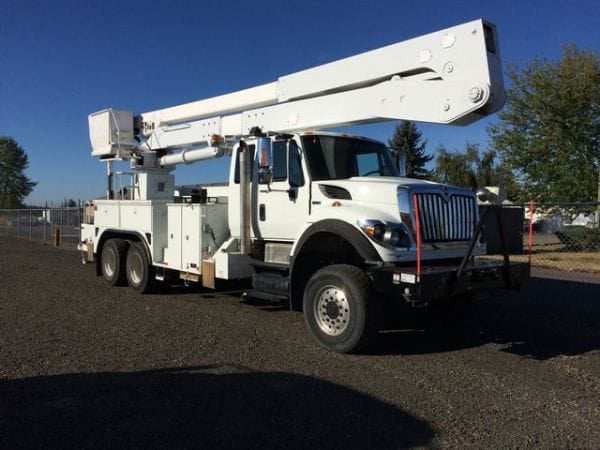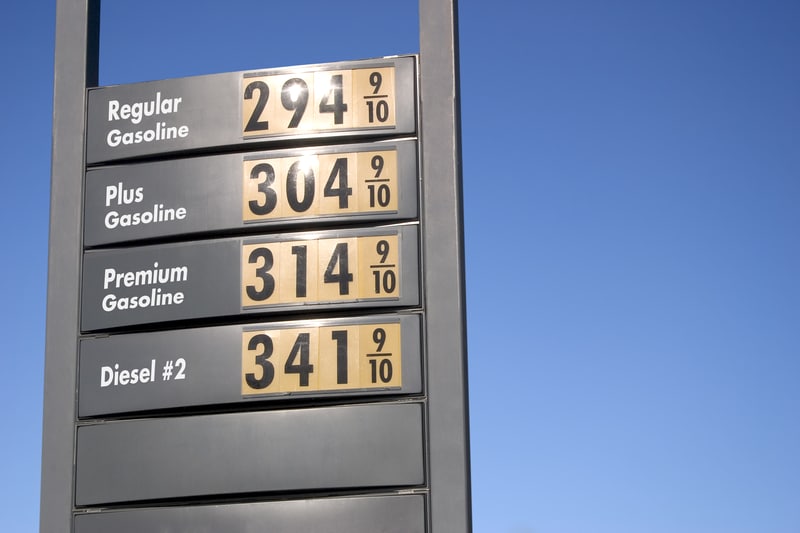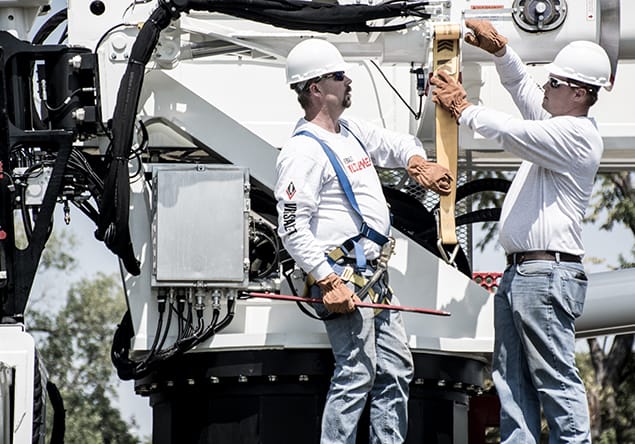For many companies, holding on to an aging bucket truck can seem like a cost-saving move. But outdated equipment often brings hidden expenses: unplanned downtime, rising repair bills, lagging performance, and safety risks that grow harder to ignore.
Recognizing the signs of decline isn’t always easy. The truck may still run, but is it still doing the job it was meant to do – efficiently, safely, and compliantly?
In this article, we’ll outline five clear indicators that your old bucket truck may be due for retirement. Whether you’re managing a single unit or an entire fleet, these warning signs can help you decide when it’s time to stop repairing – and start replacing.
One of the most common – and costly – signs that it’s time to replace your bucket truck is an increase in unplanned downtime. While all equipment requires maintenance, a truck that frequently breaks down or spends more time in the shop than on the job site is no longer serving its purpose. It’s draining resources.
As bucket trucks age, components like hydraulic systems, lift cylinders, control panels, and electrical wiring are more prone to wear. Even with regular service, the risk of failure increases over time. What starts as an occasional issue – a leaking hose or a sticking boom — can quickly evolve into chronic reliability problems that interrupt your daily operations.
These breakdowns don’t just affect your schedule. They can delay critical field work, lead to contract penalties, disrupt customer service, and frustrate your crews. And while emergency repairs may seem manageable in isolation, the cumulative cost of parts, labor, and lost productivity can easily exceed the cost of investing in a newer, more reliable bucket truck.
Additionally, older units often require harder-to-find replacement parts, resulting in longer lead times and higher repair bills. In some cases, manufacturers may have phased out specific components altogether, forcing you to rely on expensive custom solutions or second-hand parts with limited service life.
If your team is constantly adjusting schedules, renting backup equipment, or fielding calls about out-of-service trucks, that’s a clear red flag. Reliability is a core function of any bucket truck – and when that reliability fades, so does the truck’s value to your business.
A bucket truck is more than a tool — it’s a mobile work platform that lifts operators into potentially hazardous environments. That makes safety not just a priority, but a non-negotiable requirement. If your current truck lacks modern safety systems, you may be exposing your crew – and your business – to avoidable risks.
Older bucket trucks often fall short of today’s safety standards. Features that were once considered optional are now expected, and in many industries, they’re mandated by regulation or internal policy. Trucks manufactured a decade or more ago may lack key technologies that protect operators during routine operations or in the event of equipment failure.
Some of the most critical modern safety features include:
If your bucket truck lacks these features – or if the existing systems are outdated or non-functional – the risk of injury increases significantly. Beyond the human cost, this can lead to costly downtime, liability claims, and even regulatory penalties.
At Versalift, safety is built into every bucket truck we manufacture. Proprietary technologies like TruGuard™, which offers added protection against electrical hazards, and SlopeMax, which enhances safe operation on uneven surfaces, are designed to reduce risk while increasing operational confidence. These systems are not just “nice to have” – they represent the new standard for working at height.
Even if your truck seems to be performing well, ask yourself: Does it meet current safety expectations? Is it protecting your crew with the best possible tools or relying on outdated safeguards that may no longer be enough?
Upgrading to a modern bucket truck ensures that safety is never compromised. It sends a clear message to your team and your customers: we prioritize the people who make our work possible.

A well-functioning bucket truck should make every job easier, safer, and more efficient. But as equipment ages, even basic tasks can become slower, harder, or less precise. Over time, reduced performance isn’t just inconvenient – it becomes a serious barrier to productivity.
One of the first signs of performance degradation is loss of responsiveness in hydraulic systems. The boom may drift, operate at inconsistent speeds, or require more time to lift and lower. Controls may feel sluggish or less intuitive, forcing operators to compensate through workarounds – a dangerous habit in high-risk environments.
Beyond mechanical wear, older bucket trucks often lack the reach, articulation, and load capacity needed for modern job requirements. For example, a model with limited horizontal reach might not be able to access equipment mounted behind obstacles or across wide spans. A unit with a shorter boom might require additional positioning costing time and increasing jobsite complexity.
Modern bucket trucks are designed to meet evolving demands. They feature improved boom geometry, more precise controls, and greater platform stability, allowing operators to work faster and more confidently. Many also include multi-function capabilities, such as rotating platforms, tool circuits, and enhanced payload ratings – features that older models simply weren’t built to support.
As infrastructure becomes more complex and customer expectations rise, the limitations of outdated equipment become more pronounced. A truck that once covered “most” of your needs may now fall short in key areas forcing crews to improvise, double-handle materials, or request additional equipment.
When your bucket truck can no longer keep up with the scope or scale of your work, it’s no longer just aging – it’s actively slowing you down.
As bucket trucks age, their cost of ownership often increases in ways that aren’t immediately visible on the balance sheet. You may have paid off the truck years ago, but the ongoing expenses (fuel, fluids, parts, and labor) can quietly erode your operational margins.
Older units typically run on less efficient engines, often consuming more fuel than newer models that are optimized for performance and emissions. Even if your routes haven’t changed, the truck’s declining efficiency may be costing you more at the pump with every mile.
Maintenance is another hidden expense. As systems wear down, service intervals shorten and component failures become more frequent. Hydraulic leaks, electrical issues, aging seals, and outdated controls all contribute to a growing list of repairs – not to mention unexpected downtime. Parts for older models may be harder to source and more expensive, especially if the manufacturer no longer supports the unit or has phased out specific components.
What’s more, older equipment may require more manual labor to service, since diagnostic tools and modular systems are often limited or incompatible. This increases labor time and reduces workshop efficiency.
Newer bucket trucks, by contrast, are designed with total cost of ownership in mind. Modern powertrains are built for fuel economy and lower emissions, while newer hydraulic and electrical systems offer longer service intervals and more reliable diagnostics. At Versalift, we engineer trucks with simplified maintenance access, high-efficiency components, and hybrid or electric options for fleet managers looking to cut long-term fuel costs.
If your monthly maintenance log is filling up faster than your project calendar, it may be time to re-evaluate. Rising fuel and upkeep expenses are not just the cost of doing business – they’re signs that your current bucket truck is no longer cost-effective. And over time, those incremental losses can far exceed the investment in a new, more efficient machine.

Regulatory compliance is a moving target. What was acceptable a decade ago may no longer meet today’s standards for emissions, safety, or operational performance. If your bucket truck was built under outdated regulations, it could now be putting your team – and your business – at risk.
In the United States, agencies like OSHA (Occupational Safety and Health Administration), DOT (Department of Transportation), and EPA (Environmental Protection Agency) routinely update requirements related to work-at-height equipment, emissions, and vehicle safety. As these standards evolve, older equipment often falls out of step – not necessarily because it’s malfunctioning, but because it no longer meets the minimum threshold for safe or compliant operation.
Common compliance issues with aging bucket trucks include:
Non-compliance can lead to more than just regulatory fines. It can restrict access to job sites, result in failed inspections, increase insurance premiums, or trigger liability in the event of an accident. In some regions or industries, clients now require proof that all equipment on site meets current safety and environmental standards, making your old bucket truck a barrier to winning contracts.
Upgrading to a modern, fully compliant bucket truck isn’t just a legal safeguard – it’s a strategic advantage. Newer models are built to meet or exceed current regulatory requirements and often come pre-certified for use in specialized or regulated environments.
If you’re spending more time double-checking whether your equipment qualifies for the next job than actually preparing for it, that’s a clear sign: Compliance isn’t optional, and outdated trucks come with more than just mechanical risk – they come with administrative and legal ones, too.

Need to replace your bucket truck? Read our article about Choosing the Right Bucket Truck for Your Business or our guide on how to prolong the life of your bucket truck: How to Maintain Your Bucket Truck for Longevity.
No piece of equipment lasts forever – not even the most dependable bucket truck. While it can be tempting to keep an aging vehicle in rotation to avoid a major capital expense, the hidden costs of holding on often outweigh the benefits. Rising maintenance bills, growing safety concerns, limited performance, and compliance risks don’t just affect your bottom line – they compromise your crew’s efficiency and your reputation on the job.
Replacing outdated equipment isn’t about chasing the latest technology – it’s about investing in reliability, safety, and long-term operational stability. A modern bucket truck doesn’t just reduce downtime and operating costs; it empowers your team to do their work more confidently, efficiently, and in full compliance with today’s demands.
Contact our team to explore your options and learn how a new Versalift bucket truck can support your operations for years to come.
Explore related posts to learn more about Versalift’s products, customer stories, industry updates, and how we support essential infrastructure through innovation and service.
Advanced safety features like TruGuard™ and SlopeMax.
Our QA247 is the foundation of every product we assemble.
Heavyweight Performance – Best in class payloads and lighter chassis options.
We design our products with easy maintenance in mind.

Have questions about our bucket trucks or need help finding the right solution? Fill out the form below, and a member of our team will get back to you shortly.